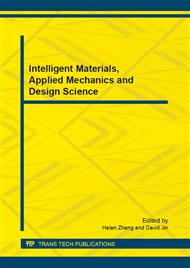[1]
C. Polk and E. Postow: Hand Book of Electromagnetic Fields, 2nd Ed., CRC Press Inc., (1996) 212-213.
Google Scholar
[2]
C. F. Blackman, J. P. Blanchard, S. G. Benane and D. E. House: J. FASEB, 9 (1995) 547-551.
Google Scholar
[3]
C. F. Blackman, S. G. Benane, J. R. Rabinowitj, D. E. House and W. T. Joines: Bioelectromagnetics, 6 (1985) 327-338.
Google Scholar
[4]
C. J. Merchant, D. C. Renew, J. Swanson, ; Exposures to Power Frequency Magnetic Field in the Home;, Journal of Radiological Protection, 14 (1994) 77-87.
DOI: 10.1088/0952-4746/14/1/008
Google Scholar
[5]
B. R. Mcleod and A. R. Liboff: Bioelectromagnetics, 7 (1986) 177-189.
Google Scholar
[6]
J. M. R. Delgado, J. Leaf, J. L. Monteagudo and M. G. Gracia, J. Anat, 134 (1982) 533-551.
Google Scholar
[7]
C. M. Chiang and C. M. Lai: A Study on the Comprehensive Indicator of Indoor Environment Assessment for Occupants' Health in Taiwan, Building and Environment, 37(2001) 387-392.
DOI: 10.1016/s0360-1323(01)00034-8
Google Scholar
[8]
N. Day, J. Skinner, E. Roman and S. G. Allen: The Lancet, 354 (1999) 1925-(1931).
Google Scholar
[9]
M. Fechting and A. Ahlbom: magnetic fields and cancer in children residing near Swedish High Voltage Power Lines, Am. J. Epidemiol., 138 (1993) 467-481.
DOI: 10.1093/oxfordjournals.aje.a116881
Google Scholar
[10]
V. Manni, A. Lisi, D. Pozzi, S. Rieti, A. Serafino, L. Giuliani and S. Grimaili: Bioelectromagnetics, 23 (2002) 298-305.
DOI: 10.1002/bem.10023
Google Scholar
[11]
J. Burnett and Y. Du: Low Frequency Magnetic Interference in High-Rise Buildings, Seventh International IBPSA Conference: Building Simulation (2001) 327-333.
Google Scholar
[12]
T. S. Tenforde and W. T. Kaune: Health Phys, 53 (1987) 585-606.
Google Scholar
[13]
N. Wertheimer and E. Leeper: Am. J. Epidemiol., 109 (1979) 273-284.
Google Scholar
[14]
A. Ubeda, J. Leaf, M. A. Trillo and J. M. R. Delgado: J. Anat., 37 (1982) 513-536.
Google Scholar
[15]
A. R. Liboff: J. Biolog. Phys., 13 (1985) 99-102.
Google Scholar
[16]
D. C. Paine, T. Whitson, D. Janiac, R. Beresford and C. Yang: Journal of Applied Physics., 85 (1999)12-15.
Google Scholar
[17]
D. Liu, D. Suqiao: Asia-Pacific Conference on Environmental Electromagnetics., (2000) 326-332.
Google Scholar
[18]
J. L. Vossen: Transparent Conducting Films, Physics Thin Films, 9 (1997) 1-71.
Google Scholar
[19]
R. M. Gresham: Plating and Surface finishing, (1998) 63-69.
Google Scholar
[20]
C. S. Zhang, Q. Q. Ni, S. Y. Fu and K. Kurshiki: Composites Science and Technology, 67(14), (2007) 2793-2980.
Google Scholar
[21]
T. Wang, G. Chen, C. Wu and D. Wu: Progress in Organic Coatings, 59(2), (2007)101-105.
Google Scholar
[22]
K. Wenderoth and J. petermann: Polymer Composites, 10 (1992) 52-56.
Google Scholar
[23]
W. W. Salisbury, Absorbent Body for Electromagnetic Waves: U. S. Patent no. 259994410. (1952).
Google Scholar
[24]
R. L. Fante and M. T. McCormack: IEEE Trans. Antenna Propagation, 36 (1998) 1443-1454.
Google Scholar
[25]
J. C. Liu, S. S. Ho and S. S. Bor: IEEE Proceeding-H, 140 (1993) 414-416.
Google Scholar
[26]
E. G. Han, E. A. Kim and K. W. Oh: Synthetic Metals, 123 (3), 2001, 469-476.
Google Scholar
[27]
White, George E., Liquid crystalline polymer and multilayer polymer-based passive signal processing components for rf / wireless multi-band applications: U. S. Patent no. 20070085108 (2007).
Google Scholar
[28]
http: /www. matter-antimatter. com/periodic_table. htm.
Google Scholar
[29]
F. Y. Hung, T. S. Lui, H. C. Liao: Applied Surface Science, 253 (2007) 7443-7448.
Google Scholar
[30]
C. T. Lin, production of PT/PZT/PLZT thin films, powders and laser direct write patterns, U. S. Patent no. 5188902 (1993).
Google Scholar


